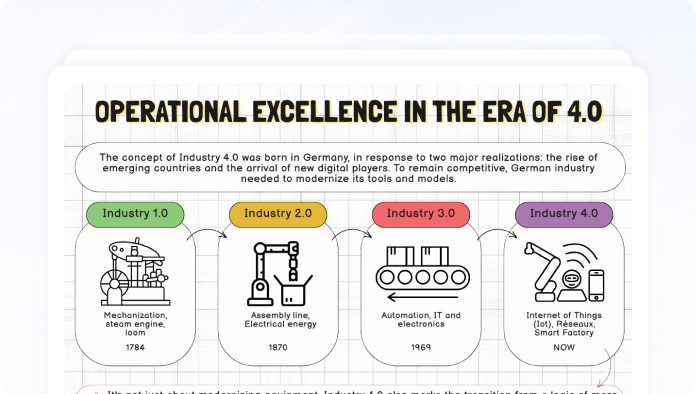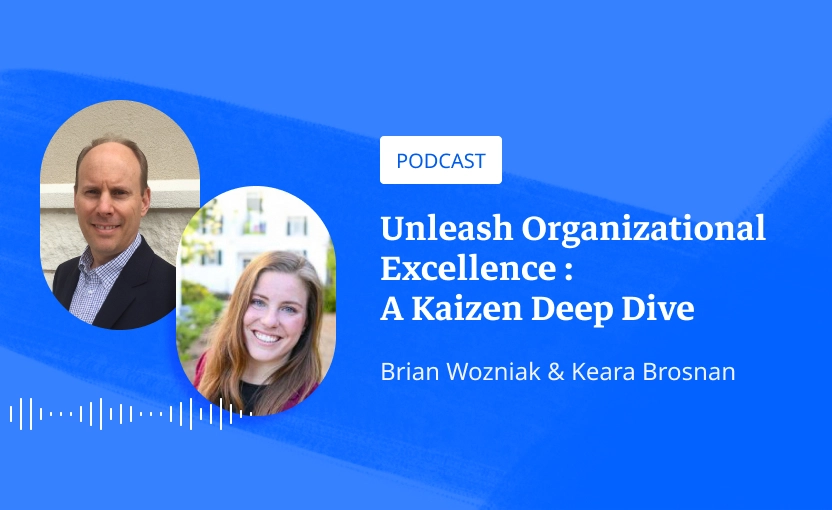Hey, let’s start your
iObeya journey!
VUCA, the Business Landscape
VUCA – Volatile, Uncertain, Complex, Ambiguous – an acronym coined in the late 1980s by the US Army War College to describe an emerging, post-Cold War world. How appropriate this acronym seems in describing the reality of our current business landscape. It’s possible that acknowledging each in terms of today’s work environment could ultimately spell business survival.
- Volatility: Most organizations suffer from a constant stream of uncontrollable events ranging from minor to exceptional. Each serves to challenge the organization’s ability to plan long-term, carry out standardization efforts and maintain a competitive edge.
- Uncertainty: Uncertainty manifests as the inability to understand current events and/or predict the future. It generally leads to poor forecasting and an increased difficulty in committing to long-term plans.
- Complexity: The higher the number of random factors and the greater the number of non-linear and fuzzy relationships between them, the more difficult it becomes to analyze the big picture, identify relevant countermeasures, and monitor impact.
- Ambiguity: Contradictory and incomplete data hinder the capability to come to a conclusion and make a decision. For example, blurry lines between partners and competitors undermine trust and challenge managers in their attempt to clarify projects and give meaning to business efforts.
In the real world, these terms work in tandem. Where there is volatility and uncertainty in the environment (i.e. world, market, organization), the more complex and ambiguous things get. Navigating such an environment, then involves agility in decision making and execution. It requires that the steering system of the company be in good health, which we find is often the case in companies with mature Visual Management and Lean practices work practices in place.
Management Practices like Lean
Businesses such as these rely on multi-stage management practices to steer operational performance, project portfolios, programs, as well as strategic alignment. These practices are the backbone – the “nervous system” – of the company (managerial brains included : ) ). Just like neurons in the human body, Lean-based team rituals – such as stand-up meetings before white boards – are a fundamental building block of the collective steering network.
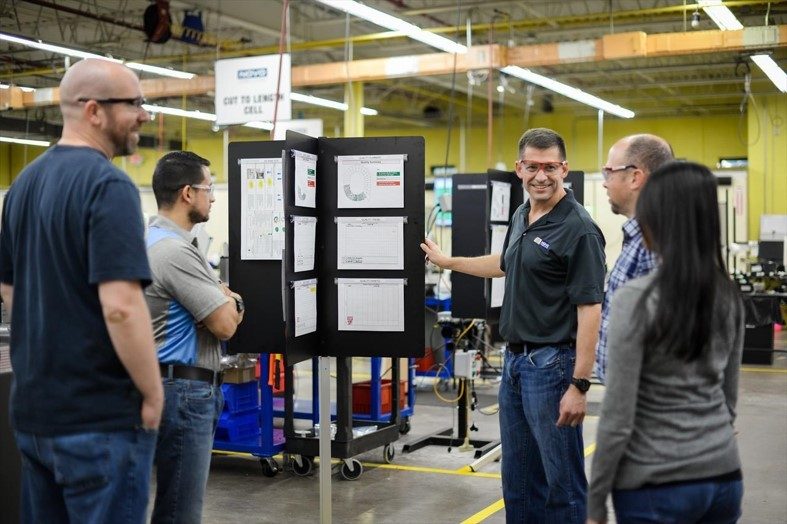
Visual Management stand-up meeting on the shopfloor.
Source: https://www.novoprecision.com/
As you can see in the image below, the feedback loop time of the whole steering system depends on the frequency, sequencing, and the quality of information passed between directors, managers and teams. The higher the frequency, the faster the response time. We can think of this as the system “clock” and those companies with efficient steering systems usually have fast ones. The quick recovery of Toyota after the 2011 tsunami / Fukushima nuclear accident clearly shows how those companies can adapt to VUCA conditions.
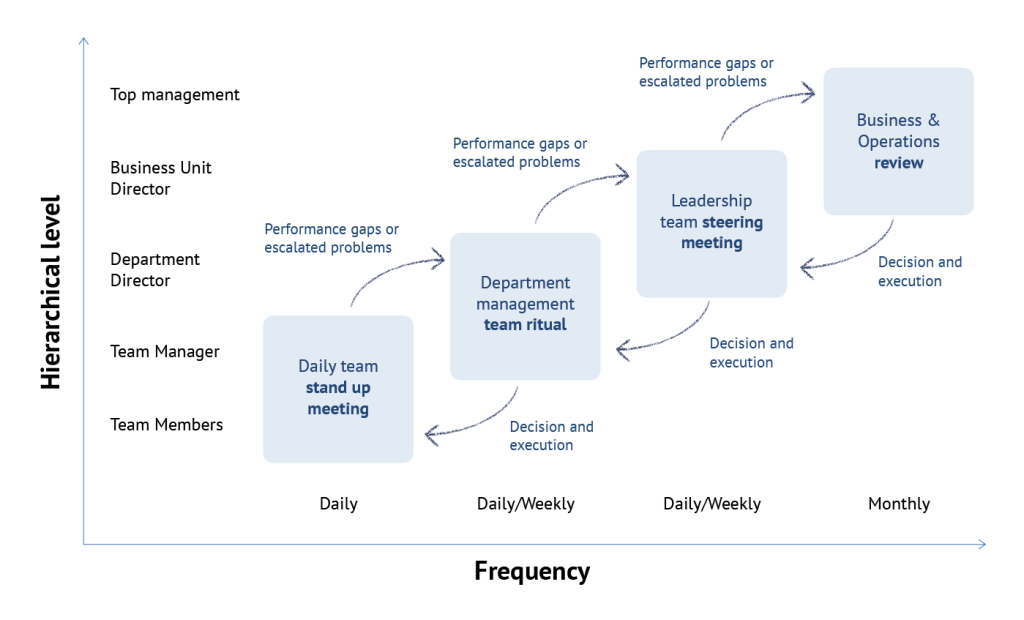
Example of a multi-stage performance management system
However, even if companies strive to be as efficient as Toyota, many struggle with today’s increasingly VUCA business environment. This is true even for companies with mature Lean/Agile practices in place, especially where limitations due to traditional paper format rituals work to slow down their responsiveness. In cases such as these, where proper digital solutions are not in place, the company’s “clock” may not be able to keep pace with rapidly changing external conditions.
Digital Visual Management for Hybrid Lean Practices and Enterprise-wide Collaboration
For example, the unprecedented constraints on today’s work environment due to Covid-19, has brought to light the fragility of both paper-based systems (need for space, co-located teams and time to update and archive information) and digital solutions not aligned with true users’ needs. That’s where Digital Visual Management (DVM) kicks in. Using digitized white boards and rooms as well as ATAWAD (anytime, anywhere, any device) accessibility, DVM fosters both remote and co-located team collaboration, while safeguarding human interactions, just like paper before it.
Target conditions are a network of interconnected virtual rooms. Each virtual room becomes the fundamental building block of this new, digital steering system, and the “playground” for team collaboration, mimicking real life war rooms or Obeyas with digital versions of white boards and sticky notes.
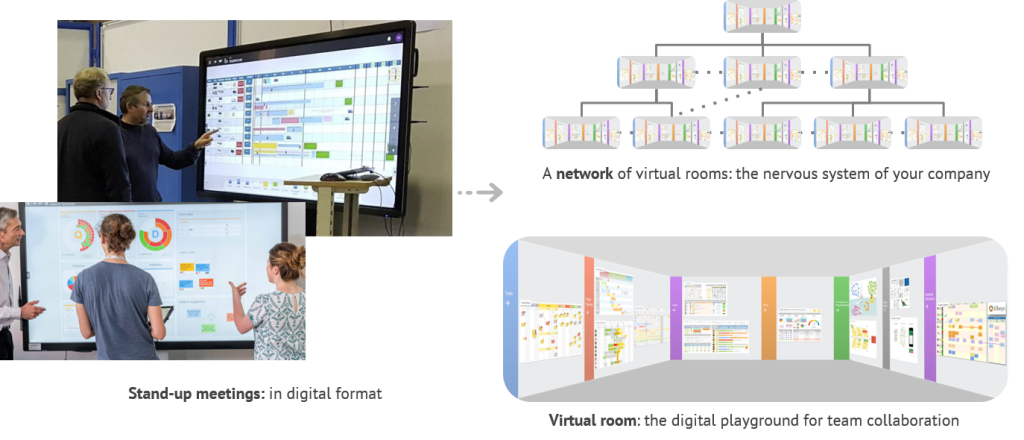
Digital Visual Management rituals (left), virtual room (bottom right), network of interconnected virtual rooms (top right). Source: Askea Design Engineering (ADI), iObeya
Virtual room networks simplify all forms of essential steering system collaboration:
- Horizontal: among operational teams in core value streams
- Vertical: across hierarchical levels, in performance management or policy deployment (also known as Hoshin Kanri)
- Diagonal: among project team members, sponsors, and stakeholders in cross-functional project management
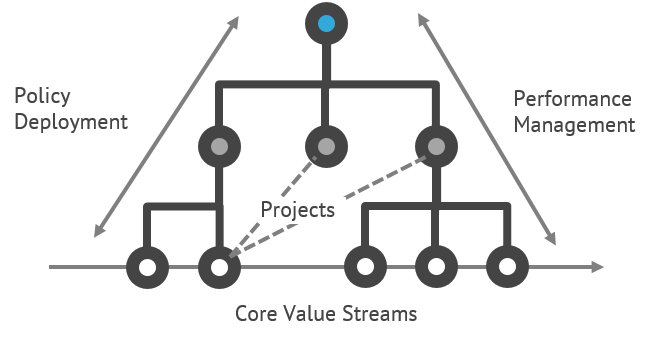
Collaboration forms in steering systems ©iObeya
For companies practicing paper Visual Management, the transition to a digital format is smooth and significant improvements are observed:
- Increased responsiveness, with feedback loop times divided by four or five
- Better knowledge management through more collaborative problem solving, simplified sharing of lessons learned and newly implemented standards
- Digital inclusivity (ex: operators improving their digital literacy)
It is interesting to mention that in decision making processes, as well as in steering systems, speed and quality are correlated: the faster you test one or multiple solutions, the faster you learn what works and what doesn’t.
For all these reasons, despite its dismal consequences, our current VUCA health crisis may actually be a driver for organizational change, pushing companies to question their habits and adopt Digital Visual Management to face present and future challenges. If you’re ready to embark on this transformation, start a conversation with an expert at iObeya.


